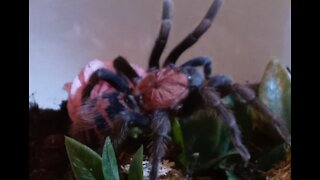Largest Big Cat In The World (Lion Tiger Hybrid - Liger)
The history of lion-tiger hybrids dates to at least the early 19th century in India. In 1798, Étienne Geoffroy Saint-Hilaire (1772–1844) made a colour plate of the offspring of a lion and a tiger. The portmanteau "liger" was coined by the 1930s.[4]
In 1825, G. B. Whittaker made an engraving of liger cubs born in 1824.[3] The parents and their three liger offspring are also depicted with their trainer in a 19th-century painting in the naïve style.
Two liger cubs born in 1837 were exhibited to King William IV and to his successor Queen Victoria. On 14 December 1900 and on 31 May 1901, Carl Hagenbeck wrote to zoologist James Cossar Ewart with details and photographs of ligers born at the Hagenbeck's Tierpark in Hamburg in 1897.
In Animal Life and the World of Nature (1902–1903), A.H. Bryden described Hagenbeck's "lion-tiger" hybrids:
It has remained for one of the most enterprising collectors and naturalists of our time, Mr. Carl Hagenbeck, not only to breed but to bring successfully to a healthy maturity, specimens of this rare alliance between those two great and formidable Felidae, the lion and tiger. The illustrations will indicate sufficiently how fortunate Mr. Hagenbeck has been in his efforts to produce these hybrids. The oldest and biggest of the animals shown is a hybrid born on the 11th May 1897. This fine beast, now more than five years old, equals and even excels in his proportions a well-grown lion, measuring as he does from nose tip to tail 10 ft 2 inches in length, and standing only three inches less than 4 ft at the shoulder. A good big lion will weigh about 400 lb [...] the hybrid in question, weighing as it does no less than 467 lb, is certainly the superior of the most well-grown lions, whether wild-bred or born in a menagerie. This animal shows faint striping and mottling, and, in its characteristics, exhibits strong traces of both its parents. It has a somewhat lion-like head, and the tail is more like that of a lion than of a tiger. On the other hand, it has no trace of mane. It is a huge and very powerful beast.
Size and growth
The liger is often believed to represent the largest known cat in the world.[1] Males reach a total length of 3 to 3.6 m (9.8 to 11.8 ft),[7][8] which means that they rival even large male lions and tigers in length.[9] Imprinted genes may be a factor contributing to the large size of ligers.[10] These are genes that may or may not be expressed on the parent they are inherited from, and that occasionally play a role in issues of hybrid growth. For example, in some dog breed crosses, genes that are expressed only when maternally-inherited cause the young to grow larger than is typical for either parent breed. This growth is not seen in the paternal breeds, as such genes are normally "counteracted" by genes inherited from the female of the appropriate breed.[11]
Other big cat hybrids can reach similar sizes; the litigon, a rare hybrid of a male lion and a female tigon, is roughly the same size as the liger, with a male named Cubanacan (at the Alipore Zoo in India) reaching 363 kg (800 lb).[12] The extreme rarity of these second-generation hybrids may make it difficult to ascertain whether they are larger or smaller, on average than the liger.
It is wrongly believed that ligers continue to grow throughout their lives due to hormonal issues.[citation needed] It may be that they simply grow far more during their growing years and take longer to reach their full adult size. Further growth in shoulder height and body length is not seen in ligers over 6 years old, as in both lions and tigers. Male ligers also have the same levels of testosterone on average as an adult male lion, yet are azoospermic in accordance with Haldane's rule. In addition, female ligers may also attain great size, weighing approximately 320 kg (705 lb) and reaching 3.05 m (10 ft) long on average, and are often fertile. In contrast, pumapards (hybrids between pumas and leopards) tend to exhibit dwarfism.
Hercules, the largest non-obese liger, is recognised by the Guinness Book of World Records as the largest living cat on Earth, weighing 418.2 kg (922 lb).[13][14] Hercules was featured on the Today Show, Good Morning America, Anderson Cooper 360, Inside Edition, and in a Maxim article in 2005, when he was only three years old and already weighed 408.25 kg (900 lb). Hercules is healthy and is expected to live a long life. The cat's breeding is said to have been a complete accident.
Valley of the Kings animal sanctuary in Wisconsin had a male liger named Nook who weighed over 550 kg (1,213 lb).[2][15]
To compare, the records for the lion and tiger in captivity are under 1,100 pounds (500 kg).
Ligers have a tiger-like striped pattern that is very faint upon a lionesque tawny background. In addition, they may inherit rosettes from the lion parent (lion cubs are rosetted and some adults retain faint markings). These markings may be black, dark brown or sandy. The background colour may be correspondingly tawny, sandy or golden. In common with tigers, their underparts are pale. The actual pattern and colour depend on which subspecies the parents were and on how the genes interact in the offspring.
White tigers have been crossed with lions to produce "white" (actually pale golden) ligers. In theory, white tigers could be crossed with white lions to produce white, very pale or even stripeless ligers. There are no black ligers. Very few melanistic tigers have ever been recorded, most being due to excessive markings (pseudo-melanism or abundism) rather than true melanism; no reports of black lions have ever been substantiated. As blue or Maltese tigers probably no longer exist, grey or blue ligers are exceedingly improbable. It is not impossible for a liger to be white, but it is very rare.
-
 6:26
6:26
SonoranHerpHaven
3 years agoTIGER RUMP (NEW WORLD T)
54 -
 2:08:10
2:08:10
LFA TV
8 hours agoEP 47: Miles Guo Trial Special with Special Guests - Truth, Betrayal, and Fox Hunt | WHISTLE BLOWERS 6.01.24 12pm EST
41.8K13 -
 1:13:59
1:13:59
Tactical Advisor
6 hours agoVault Room Tour/Unboxing- Vault Room Live Stream
34.9K3 -
 1:11:28
1:11:28
The Squad
13 hours agoArsenal's Huge Summer🚨Olise to Man Utd DEAL✅ Osimhen to Arsenal or Chelsea☑️ UCL Final Preview
46.9K8 -
 56:23
56:23
Trumpet Daily
1 day ago $1.10 earnedCohen Is Free to Lie and Steal, but Trump Is Guilty of Something - Trumpet Daily | May 31, 2024
41.2K57 -
 8:26
8:26
MichaelBisping
1 day agoBISPING CHOKES OUT STEVE-O! | JACKASS STAR PUT TO SLEEP BY UFC CHAMP! *FULL VIDEO*
56.4K13 -
 20:00
20:00
Clownfish TV
1 day agoGoogle Hurt ITSELF in Its Confusion!
64.1K58 -
 24:20
24:20
Brewzle
1 day agoWe Went Unicorn Bourbon Hunting In Louisville, KY
63K9 -
 35:39
35:39
Degenerate Jay
1 day agoGoldenEye 007 Saved James Bond - Movie Review
58.7K7 -
 14:54
14:54
Mr Reagan
1 day ago $0.46 earnedWE ARE ALL MAGA NOW
48.9K111